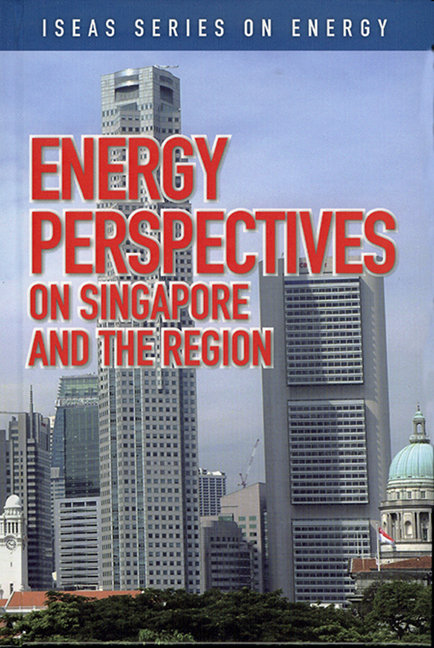Book contents
- Frontmatter
- Contents
- Foreword
- Preface
- The Contributors
- 1 Overview of Singapore's Energy Situation
- 2 Singapore's Changing Landscapes in Energy
- 3 Singapore's Role as a Key Oil Trading Centre in Asia
- 4 Large-Scale Solar PV Power Generation in Urban High-Rise Buildings in Singapore
- 5 The High-Carbon Story of Urban Development in Southeast Asia
- 6 Renewable Energy and the Environment: Technology and Economic Perspectives
- 7 Delivering Results in a Booming Rig Market
- 8 The Success Story of Rig Building in Singapore
- 9 The Singapore Oil Situation
- 10 Singapore Petroleum Company: Adding Value to the Singapore Oil Industry
- 11 Oil Storage: The Singapore Story
- REGIONAL and INTERNATIONAL
- 12 The Outlook for Energy: A View to 2030
- 13 India's Energy Situation: The Need to Secure Energy Resources in an Increasingly Competitive Environment
- 14 The Implications and Impacts of China's Oil Demand on the Asia Pacific
- 15 Energy Security Cooperation in Asia: An ASEAN-SCO Energy Partnership?
- 16 China's Energy Security: Geo-politics versus Interdependence
- 17 The Strategic Challenges for the United States and China in Global Energy Supply
- 18 China's Coal: Curse or Blessing
- 19 Japan's New Energy Strategy
- 20 Who Wins in the Asian Scramble for Oil?
- 21 New Horizons for Liquefied Natural Gas (LNG) East of Suez
- 22 Bio and Synthetic Fuels: An Alternative for Sustainable Mobility
- 23 Price Discovery for Middle East Refined Product Exports: A Natural Role for Dubai
- 24 The Outlook for Gas in Southeast Asia
- 25 Sakhalin-2 Project, a New Energy Source for the Asia Pacific: History in the Making
- Index
18 - China's Coal: Curse or Blessing
from REGIONAL and INTERNATIONAL
Published online by Cambridge University Press: 21 October 2015
- Frontmatter
- Contents
- Foreword
- Preface
- The Contributors
- 1 Overview of Singapore's Energy Situation
- 2 Singapore's Changing Landscapes in Energy
- 3 Singapore's Role as a Key Oil Trading Centre in Asia
- 4 Large-Scale Solar PV Power Generation in Urban High-Rise Buildings in Singapore
- 5 The High-Carbon Story of Urban Development in Southeast Asia
- 6 Renewable Energy and the Environment: Technology and Economic Perspectives
- 7 Delivering Results in a Booming Rig Market
- 8 The Success Story of Rig Building in Singapore
- 9 The Singapore Oil Situation
- 10 Singapore Petroleum Company: Adding Value to the Singapore Oil Industry
- 11 Oil Storage: The Singapore Story
- REGIONAL and INTERNATIONAL
- 12 The Outlook for Energy: A View to 2030
- 13 India's Energy Situation: The Need to Secure Energy Resources in an Increasingly Competitive Environment
- 14 The Implications and Impacts of China's Oil Demand on the Asia Pacific
- 15 Energy Security Cooperation in Asia: An ASEAN-SCO Energy Partnership?
- 16 China's Energy Security: Geo-politics versus Interdependence
- 17 The Strategic Challenges for the United States and China in Global Energy Supply
- 18 China's Coal: Curse or Blessing
- 19 Japan's New Energy Strategy
- 20 Who Wins in the Asian Scramble for Oil?
- 21 New Horizons for Liquefied Natural Gas (LNG) East of Suez
- 22 Bio and Synthetic Fuels: An Alternative for Sustainable Mobility
- 23 Price Discovery for Middle East Refined Product Exports: A Natural Role for Dubai
- 24 The Outlook for Gas in Southeast Asia
- 25 Sakhalin-2 Project, a New Energy Source for the Asia Pacific: History in the Making
- Index
Summary
In its quest to reduce dependence on oil and gain energy security, China is trying a high-tech solution by turning coal into transport fuel. This is not a quixotic search. The South African energy company, Sasol, makes 30 per cent of South Africa's transport fuel from coal and says it can do so profitably without government support while the price of crude oil remains above $US35 per barrel. In early August 2006, the world market price was over twice this level. Sasol is just one of several global leaders in coal-to-liquids (CTL) technology that are working with China to build new plants there that will be among the biggest and most advanced in the world.
Coal liquefaction has been given high priority by China's leaders for both environmental and strategic reasons. First, they want to want to use coal — which is by far the most important energy source available in China — in “cleaner”, or less polluting, ways. This can be done by producing liquid fuel from coal, a process that emits fewer harmful emissions into the atmosphere than burning coal for industry or in power plants to generate electricity, or using petrol, diesel, aviation fuel and other oil-derived products for transportation.
Second, China's government wants to ease reliance on imported oil, particularly supplies carried by sea from politically volatile producing states in the Persian Gulf and Africa. This oil is ferried in tankers, almost of all of which pass through the narrow and increasingly congested Straits of Malacca and Singapore in Southeast Asia on their way to Chinese ports. The straits — which funnel energy to the economic giants of Northeast Asia, China, Japan and South Korea — are seen as vulnerable to pirate and terrorist attack. Since 2003, China has also been concerned that this vital energy artery — which it does not yet have the military reach or power to protect — could be cut, at least temporarily, by a hostile blockade.
- Type
- Chapter
- Information
- Energy Perspectives on Singapore and the Region , pp. 220 - 227Publisher: ISEAS–Yusof Ishak InstitutePrint publication year: 2007



